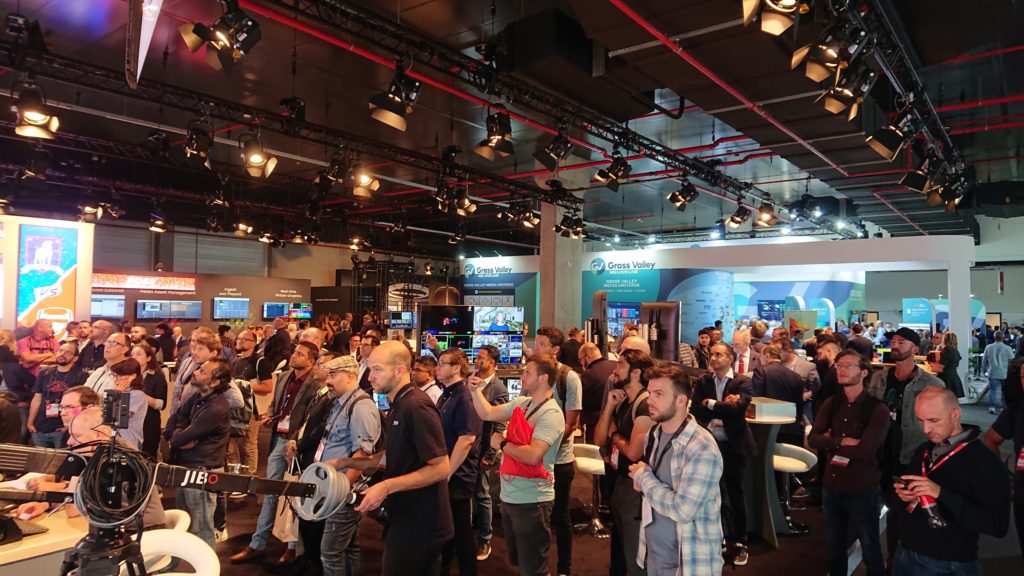Ah, trade show season, where intrepid camera specialists steal daringly into exhibition centres like Indiana Jones on the hunt for a little golden statue, trying to avoid impalenent by cargo-cult defensive devices. In this tortured analogy, the little golden statue is a tempting piece of camera equipment, and the huge rolling boulder of doom is the realisation that every piece of gear tends to need someone to look after it, and boiling down a whole grip and camera department into a stabilised gimbal with remote pan and tilt probably just means we’ll have a big crew bumping shoulders around one piece of gear.
The gear’s cheaper. The crew isn’t.
Yes, some pieces of equipment combine both functions and crew. Jimmy Jib operators have been doing all their own booming, tracking, panning, tilting, zooming, irising and focussing for decades, something that somehow requires half a dozen people around a Technocrane. People who do all those jobs on cranes and Steadicams for live broadcast, increasingly on big-chip cameras, are the ninjas of film and television and often don’t get the recognition they deserve.
Sheer human endeavour
This used to apply applied only to people with the money for big-ticket gear. At the lower end, most shows couldn’t afford more equipment than they could afford the people to operate. At first, it might seem like a great idea to build handheld stabilised gimbals with pan and tilt control, focus motors, and enormous sensors. They work wonderfully when operated by someone on a skateboard, capturing the inevitable sunset low angle of someone else on a skateboard, heavily featuring the sponsored Reeboks.
The excitable-film-student interpretation is that this obviates lots of high-end equipment. Track and dolly is a positively prehistoric idea, and cranes are obviated by a stepladder and a particularly fleet-of-foot person who combines the roles of grip, operator and focus puller. It saves on setup time, studio space, rental fees, transportation resources, street closures and doughnuts at the craft service table.
A lot of people will object to that idea because they work at the high end of single camera drama, where there’s usually one person for every lever, knob, dial or button. Obviously, they’re doing that solely because of their dedication to screencraft and their insistence on excellence, and nothing to do with job protectionism, but the big realisation here should be that all this highly-integrated equipment actually changes very little. The limit wasn’t the equipment, even when the equipment was fantastically expensive. Or – well – that was one of the limits, but another limit was the sheer human endeavour involved in controlling it all.
One Cerebral Cortex
In short, the skateboarding works, but creating the sort of thirty-second unbroken shots that a big crew can do with the best gear probably still requires the big crew. It’s really difficult to move the camera through the right path, point the camera in the right direction, set the focus to the right point, and avoid tripping over one’s own feet as the talent wanders vaguely near a mark. Human beings only have one cerebral cortex, and pursuing big-screen results in that situation is not something most humans can do reliably. It depends on the shot, but for complex stuff, even Steadicam operators on single-camera shows are generally excused the focus, iris and zoom controls.
If all this sounds like a stern, finger-wagging lecture from an increasingly middle-aged curmudgeon, well, it is, but the news isn’t all bad. No, hugely integrated camera systems don’t suddenly make it possible to pull of immensely complicated and intricate camera moves with no crew and no time, but they do make it possible to pull off immensely complicated and intricate camera moves with a decent crew, and that’s still a lot cheaper.
There are benefits beyond money, too. Anyone who’s used a slider with a fluid head – which is probably most of us – will be painfully aware that going sideways in a nice, smooth, consistent manner is easy, but that operating the camera tends to put lumps in the move that require a very light touch to avoid. A remote head is big and expensive. A gimbal with remote control isn’t. The line drawn between “gimbal” and “stabilised remote head” is fuzzy and political and determined largely by whether it was unloaded from a big white truck, but either is likely to be smaller, lighter, and easier to set up than a geared on a dolly capable of supporting that head and its operator.
Neck with Extra Bones
And, of course, the remote head operator can sit in the corner behind a monitor, feet up on a pelican case, sipping coffee between comfortably executing 720-degree pans which would otherwise demand a three-foot neck with extra bones in order to keep an eye to the viewfinder. The availability of that to small shows does make a difference, although those shows mostly still need one person to push and one person to pan and tilt.
Operating today’s feature-rich gear has affects beyond single camera work. It’s now possible, in principle, to mail some remote-control cameras to the other side of the world and produce a sophisticated broadcast from a hot desk on a not-so-nearby continent. Some of those control systems are so compact that it’s more or less impossible for a traditional gallery’s worth of production personnel to crowd around them. As technology begins to overtake the human condition, then, let’s just bear in mind that the option to put all of the controls under the hand of one person doesn’t necessarily mean that one person has the sheer mental bandwidth to operate it all.
It’d be a surprise if the trade show season didn’t offer us a lot more ways to do more things with fewer pieces of gear. Happily, they’re also a good place to meet like-minded people who might later make themselves available to operate it all.

